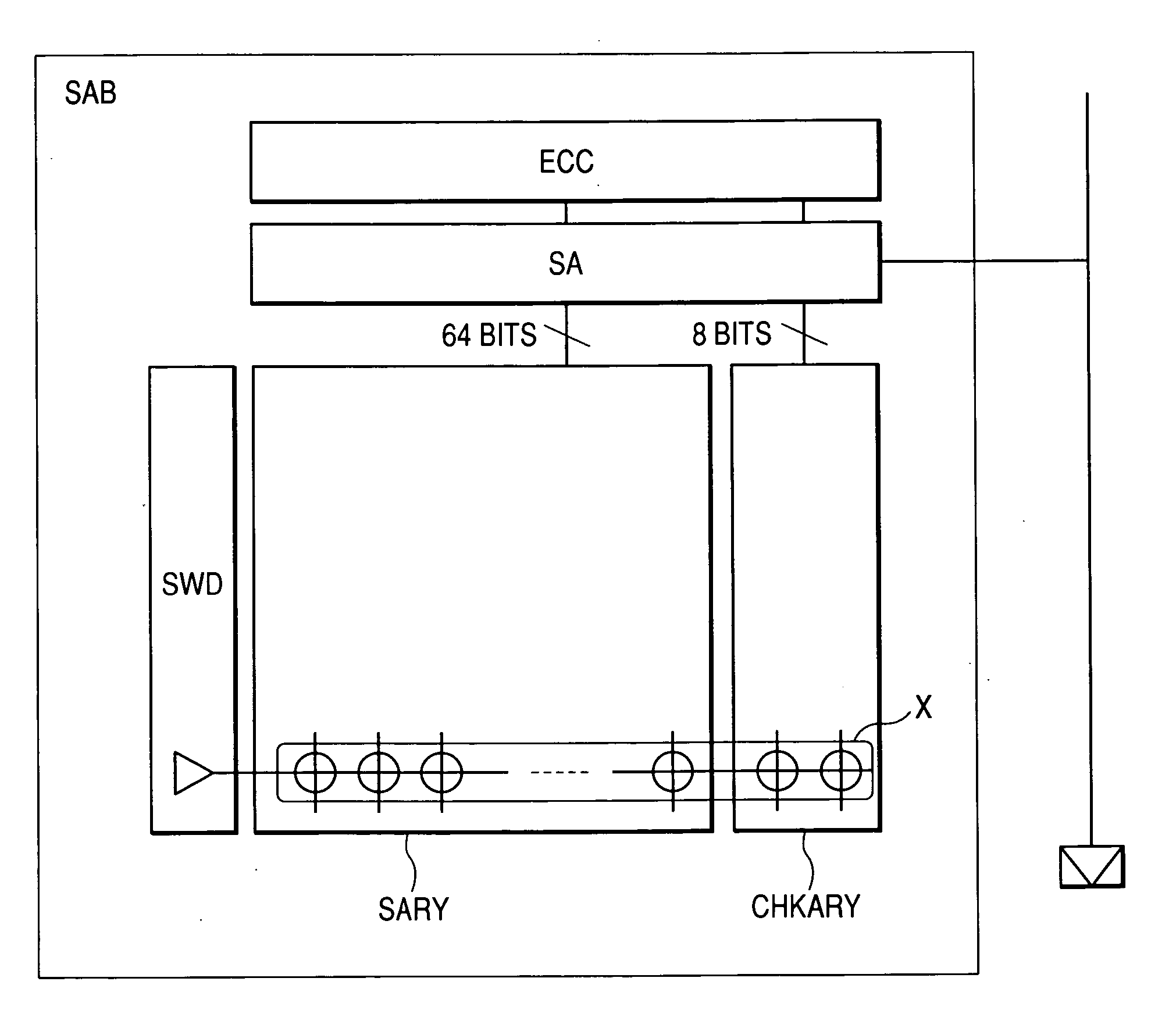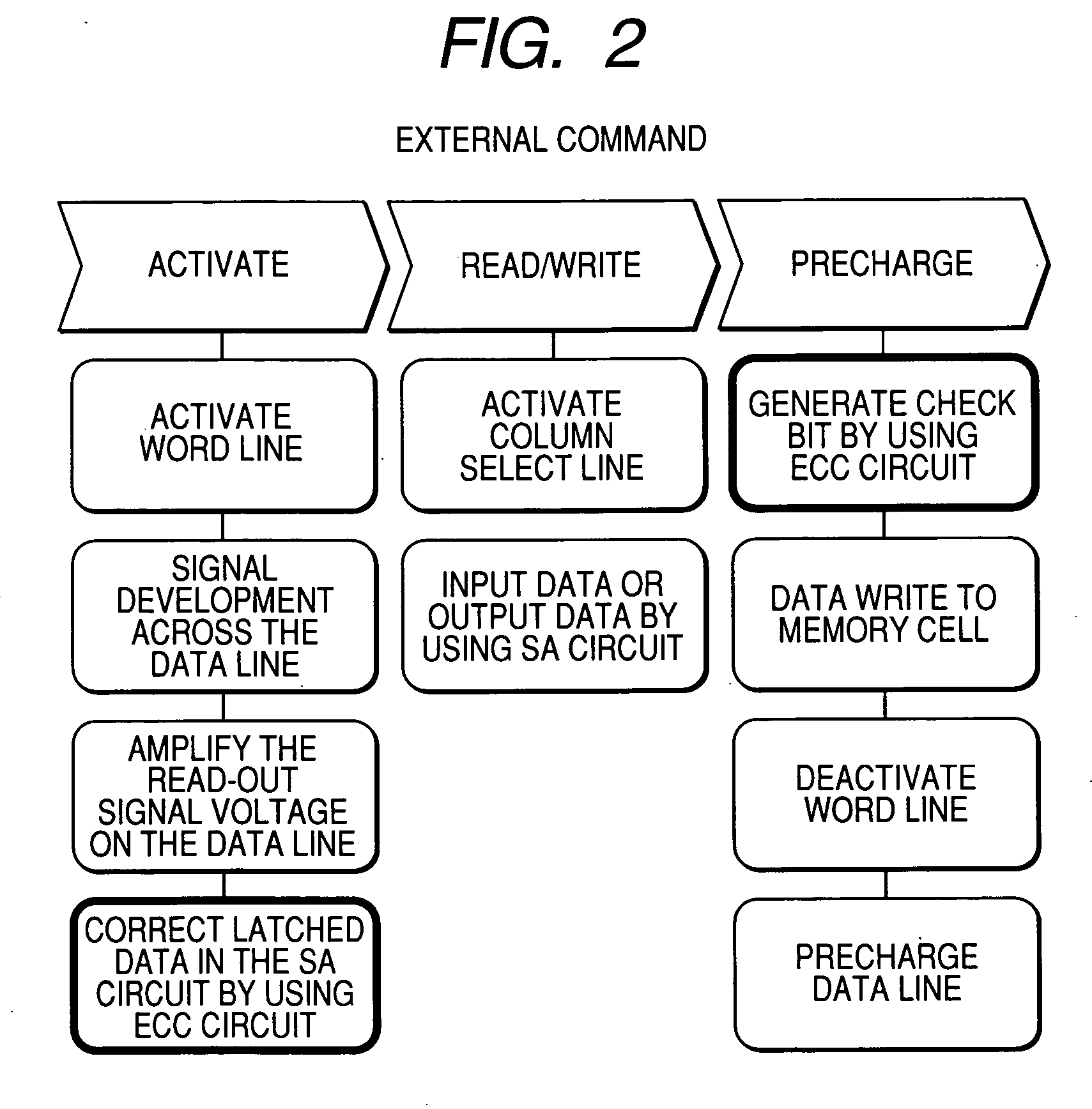Semiconductor device
a memory device and error correction technology, applied in information storage, static storage, digital storage, etc., can solve the problems of increasing power consumption, reducing power consumption, and unable to achieve low power during ordinary operation, and achieve high speed, low voltage operation, and high-integration semiconductor
- Summary
- Abstract
- Description
- Claims
- Application Information
AI Technical Summary
Benefits of technology
Problems solved by technology
Method used
Image
Examples
first embodiment
[0034] Firstly, the first embodiment according to the present invention is hereunder explained based on FIGS. 1 to 13. FIG. 1 is a conceptual diagram showing a memory array wherein an error correcting code circuit ECC as the first embodiment according to the present invention is disposed next to a sense amplifier SA, namely for each sub-array block SAB. The reference characters in the figure are as follows: SWD represents a sub-word driver to drive word lines, SARY a memory cell array in which data is stored, CHKARY a check bit array in which information for checking the existence of an error in data in the memory cell array SARY is stored, X a codeword composing one check unit, and ECC one-bit error correcting code circuit to detect and correct an error based on the data and information read out from a memory cell ARY and the check bit array CHKARY. Here, the following embodiments, unless specifically described otherwise, are based on the premise that data is read out in 64 bit uni...
second embodiment
[0049] In the first embodiment, when a readout error is produced, the wrongly readout data is corrected with an error correcting code circuit ECC. However, by means of adding redundant bits and replacing a defective bit with a redundant bit, the voltage can be lowered further than the case of not having redundant bits. As a consequence, a more reliable DRAM array can be realized.
[0050] The check matrix H shown in FIG. 14 is an embodiment of a check matrix wherein redundant bits are added to a sub-array SARY and a check matrix for redundant bits corresponding to the added redundant bits is newly added. As far as an additional check matrix is stored for redundant bits as stated above, even in the case where memory cells connected to the data lines DL8 and DL32 are defective for example, by selecting a matrix of four columns from among the check matrix for redundant bits in order to detect and correct the error on the data line of the replaced redundant bits, even when the data of the...
third embodiment
[0053] In the first and second embodiments, the explanation has been done in the case where a memory cell of a check bit array is not defective. In contrast, when a memory cell of a check bit array has a defective cell capacitor or the like, by preparing beforehand additional plural check bits and a check matrix necessary for the detection and correction of an error in the check bits and using both the check bits and the check matrix for the detecting and correcting operation of the error, it is possible to correct the error data and to realize a highly reliable DRAM array even when a defective cell exists in the check bits and simultaneously an error is produced in the data read out from a sub-array SARY. In other words, even in the case of using a simple hamming code, it becomes possible to correct two bits; one hard error bit in check bits and one soft error bit in the data read out from a sub-array SARY. As a consequence, even when a data line is operated at a low voltage, it is...
PUM
 Login to View More
Login to View More Abstract
Description
Claims
Application Information
 Login to View More
Login to View More - R&D
- Intellectual Property
- Life Sciences
- Materials
- Tech Scout
- Unparalleled Data Quality
- Higher Quality Content
- 60% Fewer Hallucinations
Browse by: Latest US Patents, China's latest patents, Technical Efficacy Thesaurus, Application Domain, Technology Topic, Popular Technical Reports.
© 2025 PatSnap. All rights reserved.Legal|Privacy policy|Modern Slavery Act Transparency Statement|Sitemap|About US| Contact US: help@patsnap.com



